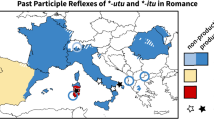Abstract
The present work reviews the first steps towards a better understanding of the acquisition of morphology in an agglutinating language, Hungarian. The acquisition of Hungarian received considerable attention from the early years of language acquisition research, but mainly production from toddlers and preschool children has been investigated. The beginning of the acquisition of morphology, in particular how infants may start to learn to decompose word forms in Hungarian, is only now starting to be explored. The current paper reviews the most recent results on this issue, and discusses its implications for language acquisition theory in general. The reviewed evidence suggests that Hungarian-learning infants are sensitive to vowel harmony by 13 months and are able to decompose morphologically complex words at 15 months. This knowledge is crucial both for word learning and for the acquisition of grammar. Indeed, agglutinating languages provide strong evidence that the sequential view of language acquisition needs to be abandoned in favor of a more integrated view where the different domains of language develop synergistically.
Access this chapter
Tax calculation will be finalised at checkout
Purchases are for personal use only
Similar content being viewed by others
Notes
- 1.
From a theoretical linguistic point of view, it needs to be noted that while many of the Hungarian suffixes are truly agglutinating in the sense that they encode a single linguistic feature only (e.g. -t the accusative case marker), some show a more fusional character, encoding multiple features (e.g. -i possessive plural marker encoding both a 3rd person possessor and the plural nature of the possessee). From the perceptive of language acquisition, it will be interesting in the future to test whether the latter types of suffixes are more challenging for infants to learn. However, in the current review, we focus mainly on suffixes that are truly agglutinating in nature, because the empirical work reported investigates these. For a detailed discussion of the linguistic questions involved, see Rebrus (2005).
- 2.
Despite its highly regular nature and its relevance for the question of word segmentation, the role of lexical stress has not been experimentally investigated yet in Hungarian infants. The question will thus not be pursued further here, but it is a promising avenue for further research.
References
Altan, A., Kaya, U., & Hohenberger, A. (2016). Sensitivity of Turkish infants to vowel harmony in stem-suffix sequences: Preference shift from familiarity to novelty. In BUCLD 40 Online Proceedings Supplements. http://www.Bu.Edu/Bucld/Files/2016/09/BUCLD_Proceedings_2016_01_25_altan1.Pdf
Audring, J., & Masini, F. (2018). The Oxford handbook of morphological theory. Oxford University Press.
Baayen, R. H., Shaoul, C., Willits, J., & Ramscar, M. (2016). Comprehension without segmentation: A proof of concept with naive discriminative learning. Language, Cognition and Neuroscience, 31(1), 106–128. https://doi.org/10.1080/23273798.2015.1065336
Baker, M. C. (2008). The atoms of language: The mind’s hidden rules of grammar. Basic books.
Batchelder, E. O. (2002). Bootstrap** the lexicon: A computational model of infant speech segmentation. Cognition, 83(2), 167–206.
Berko, J. (1958). The child’s learning of English morphology. Word, 14(2–3), 150–177. https://doi.org/10.1080/00437956.1958.11659661
Bertram, R., Schreuder, R., & Baayen, R. H. (2000). The balance of storage and computation in morphological processing: The role of word formation type, affixal homonymy, and productivity. Journal of Experimental Psychology: Learning, Memory, and Cognition, 26(2), 489.
Booij, G. (2012). The grammar of words: An introduction to linguistic morphology. Oxford University Press.
Brent, M. R., & Cartwright, T. A. (1996). Distributional regularity and phonotactic constraints are useful for segmentation. Cognition, 61(1), 93–125.
Bybee, J. (1995). Regular morphology and the lexicon. Language and Cognitive Processes, 10(5), 425–455.
Caramazza, A., Laudanna, A., & Romani, C. (1988). Lexical access and inflectional morphology. Cognition, 28(3), 297–332.
Comrie, B. (1989). Language universals and linguistic typology: Syntax and morphology. University of Chicago press.
Gergely, G., & Pléh, C. (1994). Lexical processing in an agglutinative language and the organization of the lexicon. Folia Linguistica, 28(1–2), 175–204.
Gervain, J., & Erra, R. G. (2012). The statistical signature of morphosyntax: A study of Hungarian and Italian infant-directed speech. Cognition, 125(2), 263–287. https://doi.org/10.1016/j.cognition.2012.06.010
Gleitman, L. R., & Landau, B. (1994). The acquisition of the lexicon. MIT Press. http://isbndb.com/d/book/the_acquisition_of_the_lexicon_a01
Gonzalez-Gomez, N., Schmandt, S., Fazekas, J., Nazzi, T., & Gervain, J. (2019). Infants’ sensitivity to nonadjacent vowel dependencies: The case of vowel harmony in Hungarian. Journal of Experimental Child Psychology, 178, 170–183. https://doi.org/10.1016/j.jecp.2018.08.014
Gósy, M. (1984). Hangtani és szótani vizsgálatok hároméves gyermekek nyelvében. Akadémiai Kiadó.
Harris, C. M. (1953). A study of the building blocks in speech. The Journal of the Acoustic Society of America, 25(5), 962–969.
Hohenberger, A., Kaya, U., & Altan, A. (2017). Discrimination of vowel-harmonic vs vowel-disharmonic words by monolingual Turkish infants in the first year of life. In Proceedings of the 41st Annual Boston University Conference on Language Development, 309–322.
Johnson, E. K., & Jusczyk, P. W. (2001). Word segmentation by 8-month-olds: When speech cues count more than statistics. Journal of Memory and Language, 44(4), 548–567.
Jusczyk, P. W., Hohne, E. A., & Bauman, A. (1999a). Infants’ sensitivity to allophonic cues to word segmentation. Perception & Psychophysics, 61, 1465–1476.
Jusczyk, P. W., Houston, D. M., & Newsome, M. R. (1999b). The beginnings of word segmentation in English-learning infants. Cognitive Psychology, 39(3), 159–207.
Ketrez, F. N. (2014). Harmonic cues for speech segmentation: A cross-linguistic corpus study on child-directed speech. Journal of Child Language, 41(02), 439–461.
Kiefer, F. (2000). Strukturális magyar nyelvtan 3. Morfológia (Structural Grammar of Hungarian 3. Morphology). Akadémiai Kiadó.
Ladányi, E., Kovács, Á. M., & Gervain, J. (2020). How 15-month-old infants process morphologically complex forms in an agglutinative language? Infancy, 25(2), 190–204. https://doi.org/10.1111/infa.12324
Leminen, A., Lehtonen, M., Bozic, M., & Clahsen, H. (2016). Editorial: Morphologically complex words in the mind/brain. Frontiers in Human Neuroscience, 10.https://doi.org/10.3389/fnhum.2016.00047
Leonard, L. B., Bortolini, U., Caselli, M. C., McGregor, K. K., & Sabbadini, L. (1992). Morphological deficits in children with specific language impairment: The status of features in the underlying grammar. Language Acquisition, 2(2), 151–179. JSTOR.
Lukács, Á., & Pléh, C. (1999). Hungarian cross-modal priming and treatment of nonsense words supports the dual-process hypothesis. Behavioral and Brain Sciences, 22(6), 1030–1031.
Lukács, Á., Racsmany, M., & Pléh, C. (2001). Vocabulary and morphological patterns in Hungarian children with Williams syndrome: A preliminary report. Acta Linguistica Hungarica, 48(1), 243–269.
Lukács, Á., Pléh, C., & Racsmány, M. (2004). Language in Hungarian children with Williams syndrome. Williams Syndrome across Languages, 187–220.
Lukács, A., Leonard, L. B., & Kas, B. (2010). Use of noun morphology by children with language impairment: The case of Hungarian. International Journal of Language & Communication Disorders, 45(2), 145–161.
MacWhinney, B. (1974). How Hungarian children learn to speak. UCB.
MacWhinney, B. (1975). Pragmatic patterns in child syntax. Stanford Papers and Reports on Child Language Development, 10, 153–165.
MacWhinney, B. (1976). Hungarian research on the acquisition of morphology and syntax. Journal of Child Language, 3(3), 397–410.
MacWhinney, B., Pléh, C., & Bates, E. (1985). The development of sentence interpretation in Hungarian. Cognitive Psychology, 17(2), 178–209.
Magyari, L. (2008). A mentális lexikon modelljei a magyar nyelvben. In A láthatatlan nyelv (Gervain Judit Pléh Csaba, pp. 98–119). Gondolat.
Marchetto, E., & Bonatti, L. L. (2013). Words and possible words in early language acquisition. Cognitive Psychology, 67(3), 130–150.
Marchetto, E., & Bonatti, L. L. (2015). Finding words and word structure in artificial speech: The development of infants’ sensitivity to morphosyntactic regularities. Journal of Child Language, 42(4), 873–902.
Marquis, A., & Shi, R. (2012). Initial morphological learning in preverbal infants. Cognition, 122(1), 61–66.
Mattys, S. L., & Jusczyk, P. W. (2001). Phonotactic cues for segmentation of fluent speech by infants. Cognition, 78(2), 91–121.
Mintz, T. H. (2013). The segmentation of sub-lexical morphemes in English-learning 15-month-olds. Frontiers in Psychology, 4, 24.
Mintz, T. H., Walker, R. L., Welday, A., & Kidd, C. (2018). Infants’ sensitivity to vowel harmony and its role in segmenting speech. Cognition, 171, 95–107.
Pena, M., Bonatti, L. L., Nespor, M., & Mehler, J. (2002). Signal-driven computations in speech processing. Science, 298(5593), 604–607.
Pinker, S. (1997). Words and rules in the human brain. Nature, 387(6633), 547–548.
Pinker, S., & Prince, A. (1994). Regular and irregular morphology and the psychological status of rules of grammar. The Reality of Linguistic Rules, 321, 51.
Pléh, C., & Juhász, L. (1995). Processing of multimorphemic words in Hungarian. Acta Linguistica Hungarica, 43(1/2), 211–230.
Pléh, C., & Lukács, Á. (2001). A magyar morfológia pszicholingvisztikája. BIP.
Pléh, C., Vinkler, Z., & Kálmán, L. (1997). Early morphology of spatial expressions in Hungarian children: A CHILDES study. Acta Linguistica Hungarica, 249–260.
Pléh, C., Palotás, G., & Lörik, J. (2002). Nyelvfejlödési szürövizsgálat (PPL). Akadémiai Kiadó.
Pléh, C., Lukács, Á., & Racsmány, M. (2003). Morphological patterns in Hungarian children with Williams syndrome and the rule debates. Brain and Language, 86(3), 377–383.
Rebrus, P. (2005). Hogyan inflektál a magyar. Az Ezerarcú Elme, 56–67.
Réger, Z. (1979). Bilingual gypsy children in Hungary: Explorations in ‘natural’ second-language acquisition at an early age. International Journal of the Sociology of Language, 1979(19), 59–82.
Réger, Z. (2004). The Hungarian Réger Corpus. http://childes.psy.cmu.edu/data/Other/Hungarian/Reger.zip
Saffran, J. R., & Thiessen, E. D. (2003). Pattern induction by infant language learners. Developmental Psychology, 39(3), 484–494.
Saffran, J. R., Aslin, R. N., & Newport, E. L. (1996). Statistical learning by 8-month-old infants. Science, 274(5294), 1926–1928.
Swingley, D. (2005). Statistical clustering and the contents of the infant vocabulary. Cognitive Psychology, 50(1), 86–132.
Thiessen, E. D., & Saffran, J. R. (2003). When cues collide: Use of stress and statistical cues to word boundaries by 7- to 9-month-old infants. Developmental Psychology, 39(4), 706–716.
Törkenczy, M. (2011). Hungarian vowel harmony. In The Blackwell Companion to Phonology, 2963–2990.
Van Kampen, A., Parmaksiz, G., van de Vijver, R., Höhle, B., Gavarró, A., & Freitas, M. J. (2008). Metrical and statistical cues for word segmentation: The use of vowel harmony and word stress as cues to word boundaries by 6- and 9-month-old Turkish learners. Language Acquisition and Development: Proceedings of GALA 2007, 2007, 313–324.
Acknowledgements
This work was supported by the Marie Sklodowska-Curie Actions (MSCA) Innovative Training Network (ITN) (SEP-210134423) “PredictAble” and the ERC Consolidator Grant nr. 773202 “BabyRhythm” to J.G.
Author information
Authors and Affiliations
Corresponding author
Editor information
Editors and Affiliations
Rights and permissions
Copyright information
© 2022 The Author(s), under exclusive license to Springer Nature Switzerland AG
About this chapter
Cite this chapter
Gervain, J. (2022). The Early Acquisition of Morphology in Agglutinating Languages: The Case of Hungarian. In: Gervain, J., Csibra, G., Kovács, K. (eds) A Life in Cognition. Language, Cognition, and Mind, vol 11. Springer, Cham. https://doi.org/10.1007/978-3-030-66175-5_9
Download citation
DOI: https://doi.org/10.1007/978-3-030-66175-5_9
Published:
Publisher Name: Springer, Cham
Print ISBN: 978-3-030-66174-8
Online ISBN: 978-3-030-66175-5
eBook Packages: Religion and PhilosophyPhilosophy and Religion (R0)




